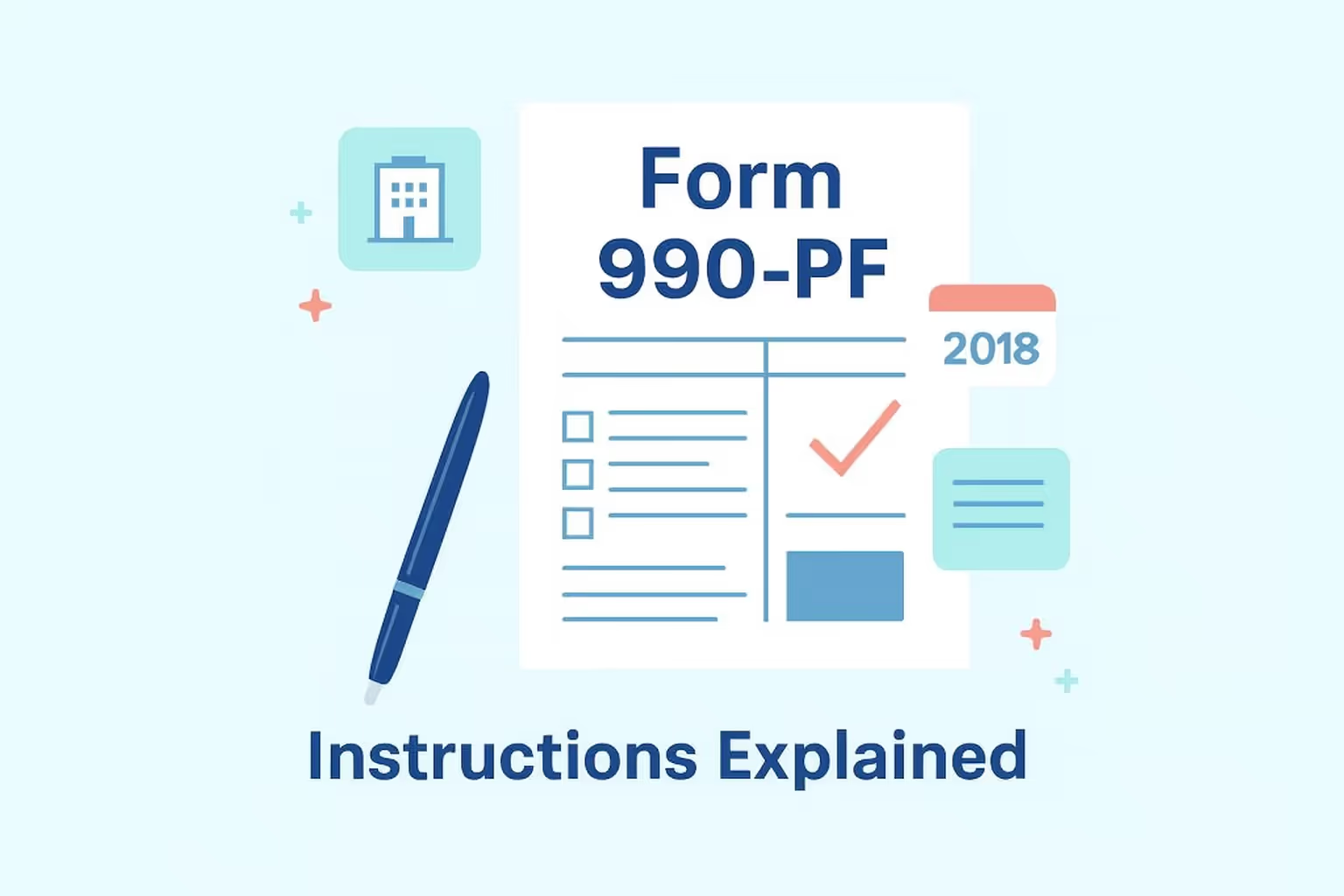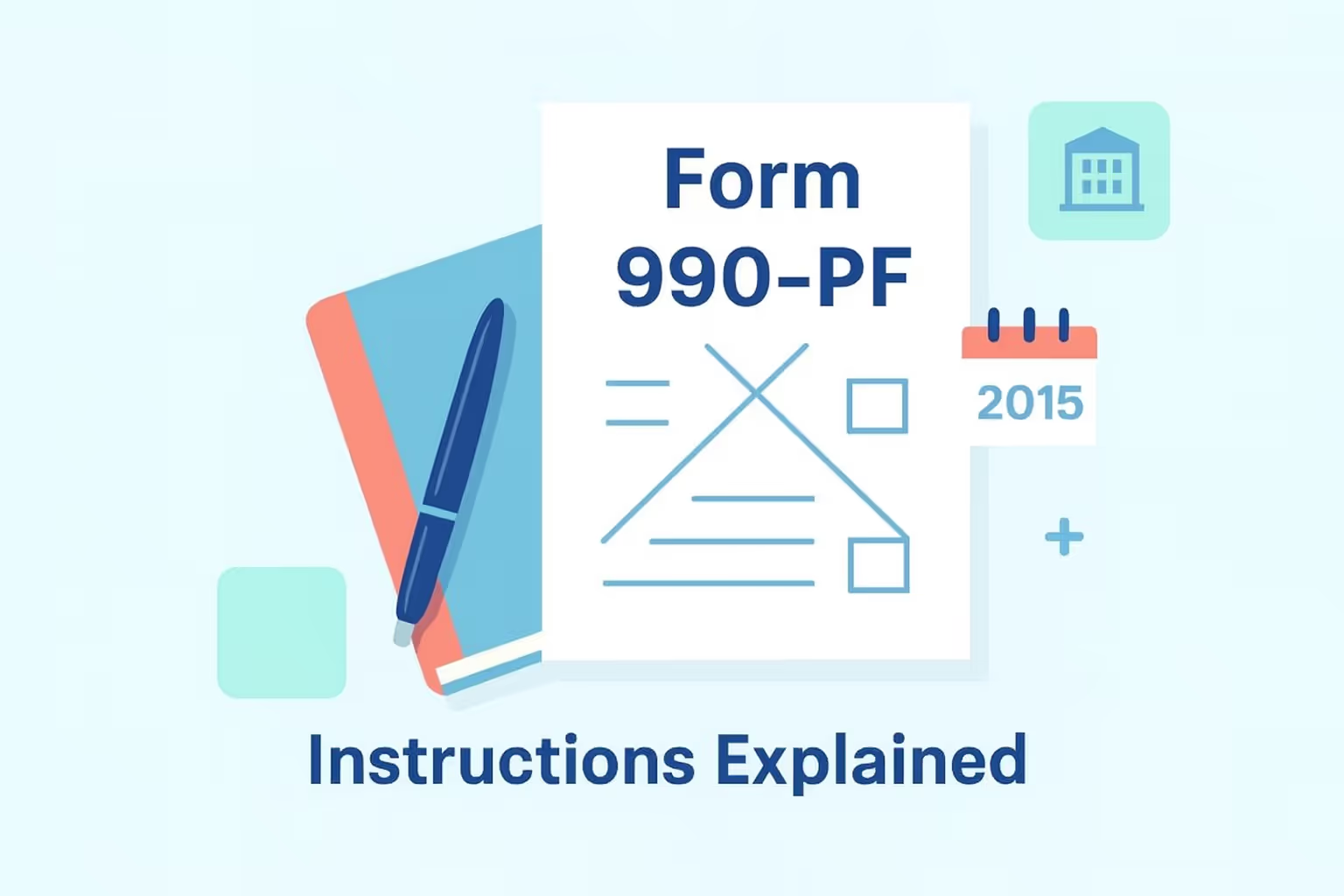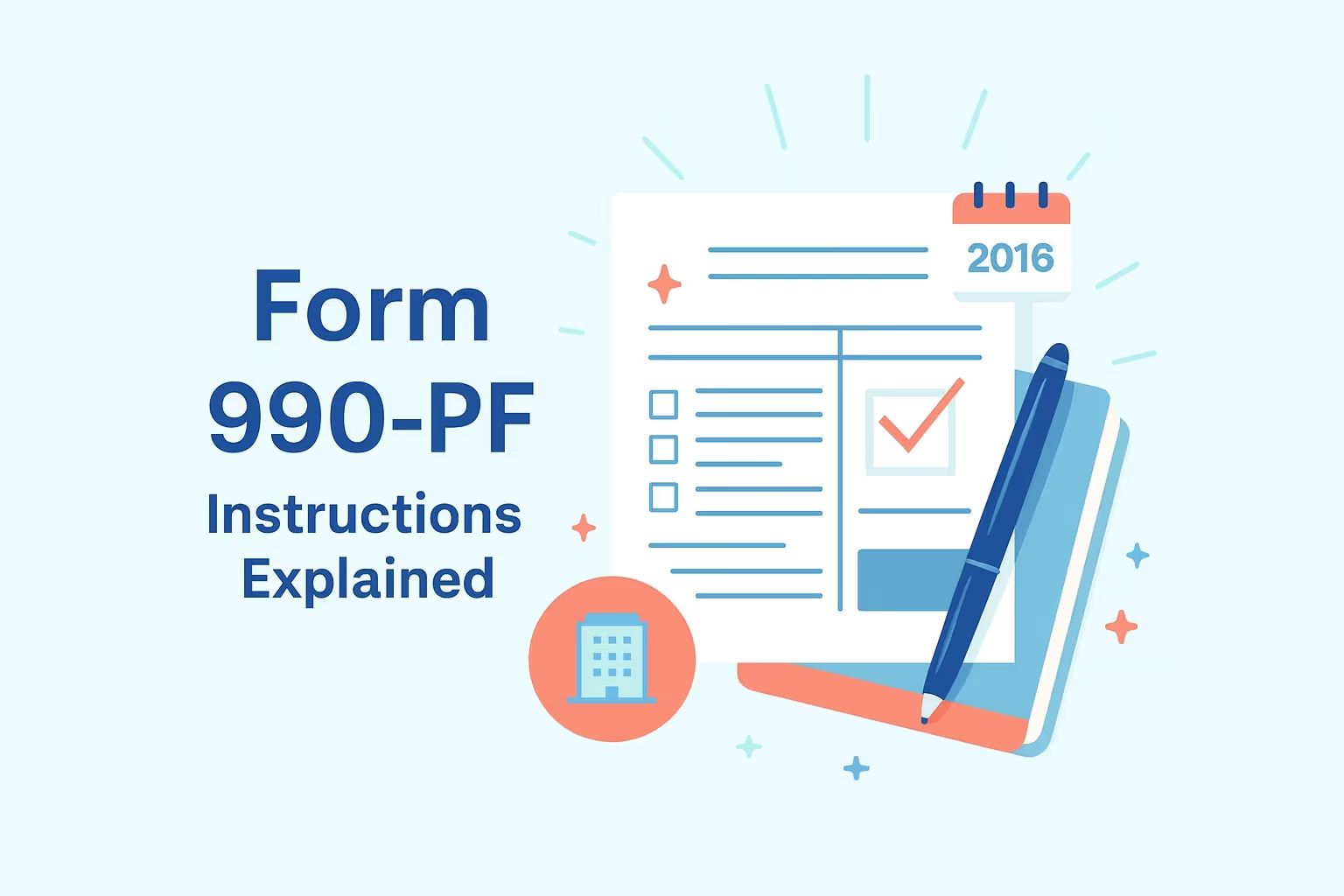Form 990-PF is the federal information return required for private foundations and certain trusts treated as foundations. Every calendar tax year, tax-exempt organizations must submit this form to the Internal Revenue Service to disclose their financial activities, charitable distributions, and compliance with federal income tax rules. Filing correctly preserves tax-exempt status, ensures fair reporting of net assets, and demonstrates accountability to donors and the public.
Completing Form 990-PF requires close attention from trustees, officers, and administrators because of its complex financial reporting requirements. The form requests details on fund balances, capital gain net income, and qualifying distributions, while also requiring clarification on accounting method choices. Private operating foundations, taxable private foundations, and nonexempt charitable trusts each face unique reporting challenges. When mistakes occur, they may lead to issues with undistributed income, excise tax-based assessments, or questions about income-producing activities.
This guide simplifies the process by walking you through the filing requirements step by step. You will learn how to report net rental income, charitable distributions, and program-related investments while aligning with federal income tax expectations. This article provides a structured explanation to help organizations maintain private foundation status while meeting federal reporting obligations.
Private Foundations Explained
Private foundations are tax-exempt organizations that support charitable, educational, or community purposes. These entities are typically funded by a single donor, family, or corporation, unlike public charities, which rely on broad public support.
Each calendar tax year, foundations must file Form 990-PF with the Internal Revenue Service to disclose income, fund balances, charitable distributions, and administrative expenses. Accurate reporting protects tax-exempt status and ensures compliance with excise tax-based rules.
An exempt private foundation operates under section 501(c)(3) and retains recognition as a tax-exempt entity under federal law. These organizations disclose net assets, adjusted net income, contributions paid, and program-related investments on Form 990-PF. Taxable private foundations, in contrast, either lost their exempt status or must pay income tax on specific activities. They remain subject to excise tax on gross investment income and must document charitable distributions, grants paid, and the fair market value of assets.
Other classifications include private operating foundations and nonexempt charitable trusts, which are treated as private foundations for tax purposes. Operating foundations primarily conduct direct philanthropic activities, rather than making grants alone, while still needing to meet distribution tests.
Nonexempt charitable trusts follow the exact reporting requirements as private foundations, including disclosure of gross receipts, capital gains, and qualifying distributions. By recognizing these categories, foundation managers can maintain transparency, protect fund balances, and ensure compliance with IRS rules throughout each tax year.
Net Assets and Fund Reporting
Private foundations are required to disclose their net assets annually to maintain compliance with the Internal Revenue Service. The return requires detailed reporting of fund balances, donor restrictions, and total net assets. These disclosures confirm the fair market value of assets and demonstrate whether charitable distributions meet federal requirements. Proper accounting of assets or fund balances helps ensure accurate excise tax-based calculations and preserves tax-exempt status.
Net asset reporting extends beyond listing liquid cash accounts. Foundations must include gross receipts, program service revenue, grants paid, and qualifying distributions. They must also reconcile capital gain, net capital loss, and adjusted net income. Recording both revenue and operating and administrative expenses creates a complete financial picture that reflects the foundation’s compliance with federal income tax rules.
Key Components in Net Asset Reporting
- Total net assets: They represent the overall value of the foundation at the start and end of the tax year.
- Fund balances: Segregated accounts that display both restricted and unrestricted funds.
- Donor restrictions: Rules attached to specific contributions that dictate how the money may be spent.
- Fair market value: It represents the value of assets, including securities, investments, and property.
- Net income adjustments: They are modifications that reconcile gross income with allowable deductions.
- Charitable distributions: They are transfers or grants that reduce taxable private foundation item exposure.
Properly documenting net assets protects the financial integrity of private foundations. By including program-related investments, contributions paid, and income-producing activities, managers confirm that the organization uses its resources responsibly. Detailed net asset reporting not only meets federal requirements but also strengthens trust among donors and beneficiaries. Accurate fund reporting reinforces transparency and demonstrates the foundation’s ability to sustain charitable operations.
Employer Identification Number and Filing Basics
Every private foundation is required to have an Employer Identification Number (EIN) to file Form 990-PF. The Internal Revenue Service uses the EIN to track compliance, verify fund balances, and connect reported income with federal income tax records. Without a valid number, a foundation cannot submit its return or disclose assets or fund balances accurately. Establishing this identification early in the calendar tax year prevents filing delays and ensures each record remains linked to the correct organization.
In addition to the EIN, Form 990-PF requires key details about the accounting method, tax year, and the foundation’s legal structure. The form asks whether the foundation applies a cash or accrual accounting method, which affects how gross income, adjusted net income, and operating and administrative expenses are recorded.
Filers must also indicate whether the entity serves as an exempt private foundation, taxable private foundation, or nonexempt charitable trust treated as a foundation. Each status carries different obligations, such as calculating qualifying distributions or reporting net rental income.
Core Filing Requirements
- Employer Identification Number: It serves as the unique identifier for every filing entity.
- Calendar or Fiscal Tax Year: It defines the reporting period and submission deadline.
- Accounting Method: This refers to the method used to measure gross receipts and expenses, either on a cash or accrual basis.
- Foundation Classification: It represents the distinction among an exempt private foundation, a taxable private foundation, or a private operating foundation.
- Disclosure of Assets: It requires reporting the fair market value of property, fund balances, and contributions paid.
Precise identification details create a foundation for accurate reporting. By correctly entering the EIN, selecting the correct accounting method, and classifying the organization, managers can protect their tax-exempt status and avoid errors that could affect excise tax-based calculations. Accurate filing information allows private foundations to remain compliant and provide verifiable records to the Internal Revenue Service.
Accounting Method and Income Categories
Private foundations must select an accounting method that determines how revenue and expenses are reported on Form 990-PF. Choosing between the cash method and the accrual method determines how gross income, adjusted net income, and operating and administrative costs are reported on the return. Each method produces a different timing of revenue and expense recognition, and consistent use ensures comparability across tax years.
Cash and Accrual Methods
The cash method records income when it is received and expenses when they are paid. This approach is often more straightforward for smaller organizations with limited fund balances or direct charitable activities. The accrual method records income when it is earned and expenses when they are incurred, regardless of when payment is made. Larger foundations that manage program-related investments, gross receipts, and contributions paid often prefer accrual reporting because it provides a clearer view of long-term financial obligations.
Income Categories
Form 990-PF requires foundations to categorize different types of income to calculate excise tax-based obligations. Gross investment income includes interest, dividends, and net rental income. Capital gain, net income, and net capital loss must be disclosed, along with income modifications that adjust taxable amounts. Unrelated business income and gross receipts from activities not related to exempt purposes must also be reported, even when subject to income tax. These categories ensure transparency in how private foundations generate resources to fund charitable distributions.
Impact on Compliance
Accurate reporting of income categories demonstrates whether a foundation has sufficient resources to qualify for distributions. By correctly applying the selected accounting method, managers can protect their tax-exempt status, avoid misclassification of assets or fund balances, and reduce exposure to taxable private foundation item errors. Detailed income reporting provides the Internal Revenue Service with verifiable records, supporting accountability and preserving the organization’s foundation status.
Investments and Temporary Cash Holdings
Private foundations must report their investments and temporary cash holdings on Form 990-PF to show how assets are managed throughout the tax year. These disclosures confirm compliance with Internal Revenue Service requirements, ensure that resources are tied to exempt purposes, and demonstrate accountability in maintaining tax-exempt status.
- Purpose of reporting: Foundations report both long-term investments and short-term holdings to show that income is applied to charitable distributions. This process demonstrates compliance with excise tax-based obligations and clarifies how resources align with exempt purposes. Transparency strengthens accountability and preserves the foundation’s role as a tax-exempt organization.
- Temporary cash investments: Short-term holdings such as certificates of deposit and money market funds provide liquidity for immediate operating and administrative expenses. They are reported separately from long-term assets to reflect how fund balances are actively managed. Recording both categories gives a complete picture of financial health during the tax year.
- Program-related investments: These are directed toward advancing exempt purposes while producing modest financial returns. They differ from general investment holdings because their primary function is to support charitable goals, rather than generating income. Proper disclosure distinguishes them from other securities and protects compliance.
- Capital gains and income: Foundations must report capital gain net income, net capital loss, and gross investment income, including dividends and net rental income. These disclosures impact adjusted net income, excise tax-based obligations, and qualifying distributions. Accurate reporting of these categories ensures fair application of federal income tax rules.
- Fair market value and fund balances: Assets must be valued as of the last day of the reporting period, while fund balances must reflect both restricted and unrestricted amounts. Donor restrictions tied to contributions are also disclosed to confirm accurate accounting of total net assets. These measures support reliable reporting and compliance with Internal Revenue Service requirements.
- Oversight and accountability: Officers, directors, and trustees must ensure accurate reporting of investments, estimated tax payments, and income modifications. Detailed disclosures reduce the risks associated with taxable private foundation items and strengthen public confidence. Responsible investment reporting supports long-term sustainability, enabling the foundation to continue fulfilling its charitable mission.
Charitable Distributions and Compliance
Private foundations must demonstrate that they meet distribution requirements each year to retain their tax-exempt status. These distributions, reported on Form 990-PF, reflect the foundation’s commitment to public benefit and confirm compliance with Internal Revenue Service regulations. Proper calculation and documentation ensure that resources are allocated to exempt purposes rather than accumulating unused.
Steps for Compliant Charitable Distributions
- Calculate the minimum investment return: Determine the fair market value of assets or fund balances to establish the required distributable amount. This calculation confirms that private foundations use their resources effectively to benefit the public.
- Determine the distributable amount: Apply the 5% rule, which requires foundations to distribute at least 5% of their average net assets annually. This ensures program-related investments, grants paid, and direct charitable activities meet the compliance threshold.
- Identify qualifying distributions: Record grants, contributions paid, and expenses directly tied to charitable purposes. Qualifying distributions reduce exposure to excise tax-based obligations and demonstrate adherence to Internal Revenue Service rules.
- Account for administrative expenses: Include operating and administrative expenses that support exempt activities, while separating costs not connected to charitable work. Precise classification of expenses maintains transparency and reduces the risk of errors related to taxable private foundation items.
- Address undistributed income: Track any remaining amounts not distributed by year-end. Foundations must either distribute the balance in the following year or face additional excise tax-based assessments. Proper management of undistributed income helps avoid compliance issues and protects the private foundation's status.
- Maintain accurate records: By documenting contributions, net income adjustments, and income-producing activities throughout the tax year. This consistent recordkeeping helps officers, directors, and trustees demonstrate accountability in meeting distribution requirements.
Charitable distributions represent a central requirement for private foundation compliance. By following the required steps, managers ensure compliance with federal income tax expectations while reinforcing public trust. Proper planning, accurate reporting, and precise calculations confirm that foundations use their assets responsibly to achieve lasting charitable impact.
Foundation Managers and Governance
Governance within private foundations depends on the leadership and accountability of foundation managers. Officers, directors, and trustees are responsible for ensuring compliance with Internal Revenue Service requirements.
Their role includes overseeing charitable distributions, monitoring income-producing activities, and protecting tax-exempt status through accurate reporting. Strong leadership builds confidence among donors and reinforces the foundation’s long-term credibility.
Compensation reporting also plays a crucial role in effective governance. Highly paid employees and officers must have their compensation disclosed on Form 990-PF, ensuring transparency and accountability. Accurate reporting prevents errors in classifying expenses that may be treated as taxable items of a private foundation. Establishing reasonable compensation practices also reduces scrutiny and supports public confidence.
Trustees and directors make decisions about investment strategies, fund balances, and program-related activities. Governance structures demonstrate responsible stewardship of assets by documenting policies, managing conflicts of interest, and safeguarding donor restrictions. Effective oversight ensures that grants paid and contributions align with exempt purposes while avoiding prohibited transactions. In this way, governance strengthens compliance, reinforces accountability, and sustains the foundation’s ability to pursue its mission.
Filing and Submission Process
Every private foundation is required to file Form 990-PF electronically to meet federal requirements. The Internal Revenue Service no longer accepts paper returns, which means organizations must prepare and submit them through approved e-file providers. A structured approach helps managers complete the return accurately, avoid delays, and maintain tax-exempt status.
Step 1: Gather Required Information
Collect the Employer Identification Number, financial records, program-related investment details, and data on charitable distributions. Include documentation of fund balances, administrative expenses, and income-producing activities. Having comprehensive documentation ensures accuracy across all parts of the return.
Step 2: Prepare the Return
Enter gross income, net rental income, capital gain net income, and adjusted net income into the correct sections—complete fund balance disclosures, qualifying distributions, and reports of grants paid. Review for consistency between net assets and reported charitable activities.
Step 3: Attach Schedules and Documents
Upload required schedules, including donor restrictions, fair market value disclosures, and program service revenue details. Ensure that attachments, such as contributions paid or highly paid employee records, are correctly formatted. Each supporting document must align with Internal Revenue Service requirements.
Step 4: Submit Electronically
Choose an IRS-approved e-file provider or authorized preparer. Validate the return for errors, authorize the electronic signature from a trustee or officer, and submit through the provider’s system. The IRS E-file for Charities and Nonprofits page outlines the filing process and lists approved providers that support electronic submission.
Step 5: Track Payments and Deadlines
If excise tax-based obligations or estimated tax payments remain, schedule payment through the Electronic Federal Tax Payment System. Meeting deadlines for both the annual return and any required payments protects compliance and avoids unnecessary costs.
Following a structured submission process strengthens accountability and confirms the foundation’s compliance with federal requirements. By following each step with precision, managers ensure accuracy, safeguard the foundation’s private status, and maintain credibility with both regulators and donors.
Payment Rules and Excise Tax
Private foundations must carefully calculate their excise tax obligations to remain compliant with Internal Revenue Service requirements. These obligations apply to net investment income and affect whether estimated tax payments are necessary during the tax year. Correctly reporting excise tax ensures accuracy in contributions paid, program-related investments, and income-producing activities.
Excise tax is calculated based on net income from dividends, interest, net rental income, and capital gains. The permanent rate of 1.39% applies to all taxable private foundations regardless of size or activity level. This rate affects distributable amounts and the timing of qualifying distributions that safeguard exempt purposes.
Comparison of Payment Methods
1. Electronic Federal Tax Payment System (EFTPS)
- Key Features: Allows scheduling of federal tax payments online with confirmation numbers.
- Considerations: Requires advanced setup and is best suited for ongoing excise tax-based payments.
2. Electronic Funds Withdrawal (EFW)
- Key Features: Authorizes direct debit during electronic filing.
- Considerations: Must be approved at the time of filing and cannot be cancelled once initiated.
3. Credit or Debit Card
- Key Features: Uses IRS-approved processors to pay excise tax obligations immediately.
- Considerations: Convenience fees apply; best for short-term or smaller tax-paid obligations.
4. Check or Money Order
- Key Features: A traditional method for making annual or estimated tax payments.
- Considerations: Slower processing time; must include the foundation name and Employer Identification Number (EIN).
Excise Tax Application
- Calculation: Net investment income × 1.39% = excise tax due.
- Estimated Tax Payments: Annual excise tax payments are required if the amount is expected to exceed $500.
- Carryovers: Excess qualifying distributions can offset future obligations.
- Accountability: Officers, directors, and trustees must confirm accurate classification of income modifications and deductions.
Detailed excise tax rules, including guidance on calculating net investment income and reporting payments, are outlined in the IRS Form 990-PF instructions. By applying these standards, foundations maintain their tax-exempt status while avoiding errors in reporting gross investment income, adjusted net income, and other taxable items.
Established payment procedures and accurate excise tax reporting support compliance, providing measurable accountability. Foundations that follow structured rules demonstrate responsibility in managing assets or fund balances, ensuring their charitable activities continue without disruption.
Common Errors to Avoid
Completing Form 990-PF requires careful attention to detail. Mistakes in reporting net assets, capital gain, net income, or contributions paid can result in compliance issues for both exempt private foundations and taxable private foundations. Understanding frequent errors helps officers, directors, and trustees reduce risks and maintain accurate reporting.
One common issue involves the incorrect classification of income, such as failing to distinguish between unrelated business income and gross investment income. Errors also arise when organizations fail to make program-related investments, miscalculate the fair market value of fund balances, or misreport grants paid as operating and administrative expenses. Consistency across parts of the form is critical for maintaining compliance with Internal Revenue Service rules.
Frequent Filing Mistakes
- Omitting Schedule B: Failure to provide contributor details or incorrectly claiming an exemption can lead to reporting issues.
- Misreporting Net Assets: Failing to distinguish between restricted funds, donor restrictions, or assets and fund balances properly affects financial accuracy.
- Incorrect Excise Tax-Based Calculations: Using outdated rates or including ineligible income reduces filing accuracy.
- Incomplete Balance Sheets: Skipping required lines or failing to reconcile beginning and ending totals undermines reporting integrity.
- Improper Signature Authorization: Submitting without the required officer, trustee, or accounting officer’s signature invalidates the return.
- Mathematical Errors: Inaccurate adjustments to net income or net capital loss values lead to inconsistencies across parts.
Preventing these mistakes requires a thorough review before submission. Comparing totals across sections, verifying gross receipts against distributions, and ensuring income modifications are correctly applied can safeguard compliance. By focusing on accuracy and aligning with IRS requirements, private foundations reinforce accountability, maintain their tax-exempt status, and reduce the risk of misreporting, while also strengthening transparency in their operations.
Frequently Asked Questions
What does it mean to claim private foundation status?
To claim private foundation status, an organization must file the appropriate IRS Form at inception and maintain compliance with the Taxpayer Act. Filing establishes the group as a tax-exempt entity distinct from noncharitable exempt organizations or public charities. Once status is granted, the foundation must demonstrate ongoing compliance by managing its assets responsibly and ensuring that charitable purposes remain central to its operations.
How should a foundation report charitable distributions?
Private foundations are required to report charitable distributions on Form 990-PF, including grants, direct philanthropic activities, and program-related investments. Accurate disclosure ensures compliance with minimum distribution requirements and supports the organization's continued tax-exempt status. Reporting also involves identifying recipients and purposes of contributions. By carefully documenting these distributions, foundations establish transparency, preserve trust, and demonstrate alignment with federal rules governing charitable use of assets and fund balances.
Are employee benefit plans considered qualifying expenditures?
Employee benefit plans may be included in administrative expenses, but they are not generally classified as qualifying distributions. While benefit costs can be reported under operating and administrative expenses, they do not count toward the minimum charitable payout requirement. Foundations must still report charitable distributions separately. The distinction ensures compliance with federal rules while allowing officers, directors, and trustees to manage employee-related costs in accordance with IRS guidance.
How do noncharitable exempt organizations differ from private foundations?
Noncharitable exempt organizations, such as social welfare or business leagues, differ from private foundations because they do not claim private foundation status. These groups qualify under separate sections of the Internal Revenue Code. While both are considered tax-exempt, noncharitable organizations have distinct filing requirements and are not subject to the same excise tax rules. Private foundations must instead follow specialized IRS Form 990-PF reporting, ensuring compliance with stricter standards.
What tax shelter transactions are prohibited for foundations?
Prohibited tax shelter transactions occur when private foundations engage in abusive tax arrangements designed to avoid federal income tax. These transactions can jeopardize the organization's exempt status and expose it to excise tax. Common issues include misuse of specific personal benefit contracts or improper investments designed to generate unfair advantages. Foundations must carefully review all transactions to ensure compliance with federal law and maintain their exempt status as private foundations.
When should a foundation consider claiming operating foundation status?
Foundations may consider claiming operating foundation status if they primarily conduct direct charitable activities, rather than focusing solely on grantmaking. To claim this status, they must demonstrate through the IRS Form that most resources are used to fund operations or services. Operating foundations must meet specific tests outlined in the Taxpayer Act. This classification enables organizations to allocate resources directly to mission-driven programs, while maintaining accountability and federal recognition.
How does the cash accrual accounting method affect reporting?
The cash accrual method of accounting determines how a foundation records revenue and expenses on its IRS Form 990-PF. Under the cash method, transactions are reported when received or paid. Under the accrual method, income and expenses are recorded when earned or incurred. Choosing between methods affects how fund balances, contributions, and specific personal benefit contracts are reported. Foundations must use a consistent process across tax years to ensure accurate and transparent reporting.





























